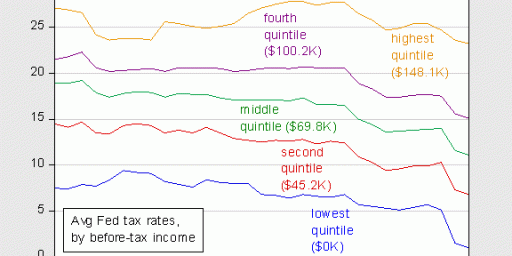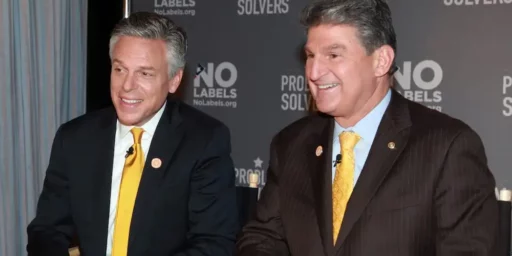LABELS
Kevin Drum has been taken to task for admitting his views put him “in the leftward 20% of the country.” His analysis of this is quite interesting, especially his differentiation between the “types” of moderation.
I would agree with Kevin that his views are likely in the leftward quintile of the American population, and would think my views fall somewhere in the right quintile. Indeed, the mere fact that we spend a lot of time thinking, let alone writing, about politics and have developed somewhat coherent positions almost by definition puts us into the extremes.
The key thing is that Kevin does engage in “rhetorical moderation,” which means that people who disagree with him can find him worth reading. There’s not much point in my reading most of the leftish blogs out there because I just find them insulting. (Indeed, there are some popular rightish blogs I avoid because there rhetorical excess clouds their argument.) I often wonder what these people think they’re accomplishing. Routine use of labels like wingnuts, fascist, Nazi, communist, pinko, homophobe, racist, unamerican, and many others is interesting as red meat but is rather unlikely to persuade anyone who doesn’t already agree with your position. The occasional quip or over-the-top analogy can flavor the discussion, but constant ad hominem attacks are going to put off most readers.
I would also note that “moderate” is very much a moving target, anyway. The idea that blacks should be treated exactly like whites, for example, made one a radical in the 1850s, a liberal in the 1960s, a moderate in the 1970s, and a conservative in the 1990s. Right now, being pro gay marriage is liberal, tolerance of homosexual sodomy is moderate, and thinking homosexuality a sinful “lifestyle choice” is conservative. In twenty years, I suspect the labels will be much changed.
Update: Chris Lawrence has some thoughts on this as well.
Update (22:08) A commenter notes that there are actually all manner of conservatives. This is true in the popular sense of the word but less true in the traditional sense. See this old post for more discussion of that problem.






The idea that ones views on many issues, including homosexuality is conservative, liberal or moderate is simplistic. Conservatism is hardly monolithic. While there is a faction, mainly the religious right, of conservatism that views homosexuality as a ‘sinful lifestyle choice’, it is only a faction. The fiscal conservatives could care less, if they tried, but they’d have to try real hard.
The libertarian (note the small L, please) wing of conservatism also isn’t particularly interested in the issue. Ditto the gun rights crowd.
While I, as a conservative, disagree with much of the organised gay agenda it is by no means because of whom they share a bed with. It’s because much of that agenda is Leftist. I disagree with the capital F Feminist agenda for the same reasons, not because I think being a woman is a ‘sinful lifestyle choice’.
I think your description of Kevin hits on one thing which I’ve considered important in the blogs I read for some time now — tone is as important as substance. And while the comment sections of blogs may or may not add to the substance of what is posted, they do add a lot to the tone, especially when you’re dealing with comment “communities” like we find on Tacitus, Kos, and the like. I don’t read LGF or Atrios precisely because comments there get so vitriolic that any value to reading the blog is lost.
The idea of the always-evolving liberal-moderate-conservative spectrum is a familiar one, though I think a circular rather than linear pattern might also exist, especially with regard to ideas and public figures. For example, Edmund Burke, by way of his interpreters, has been, at various points, a liberal, a reactionary, a conservative, and a liberal once again. I think it’s difficult to even pigeonhole many social issues as having a conservative/liberal dimension.
What’s curious about Kevin’s thread is that, to me, Bush is an extremely unideological (almost Clintonesque) Republican who has a vague sense of “being conservative” without acting conservative enough to alienate swing voters. However, in Kevin’s thread you get the sense that Democrats envison Bush as a raving partisan (the same way Republicans saw Clinton), and because they don’t perceive Bush to be staking out a wide swath of the real middle — “he’s way over on the right, I tell you!” — they advocate a kind of “false middle” wherein, among other things, DLC-bashing is seen as a “moderate” position.
I just finished “The Neoconservative Vision” by Mark Gerson. He makes a number of good points. Most of the first generation neoconservatives came there from liberalism, and probably still consider themselves liberal. They are far from libertarian, positing a strong government for the benefit of society that cosniders that actions have consequences. Also, that it is silly to put the fascists on the right and the communists on the right. They strongly opposed both for the same reason – they are both strongly totalitarian.
The book was written pre-Bush(43), but I see much neoconservative influence in his Presidency. This is probably not coincidental, as Rumsfield and both of the Cheneys are mentioned in the book.
The neocoservatives are intellectuals, and Bush most assuredly is not, but has surrounded himself with such, many of whom are at least familiar with neoconservative thought.
I would consider the Bush (43) Presidency to be a combination of neoconservativism and traditional conservativism, with a leaning to the former, but with a modicum of electoral expediency, most notably the Medicare Drug Benefit.
—